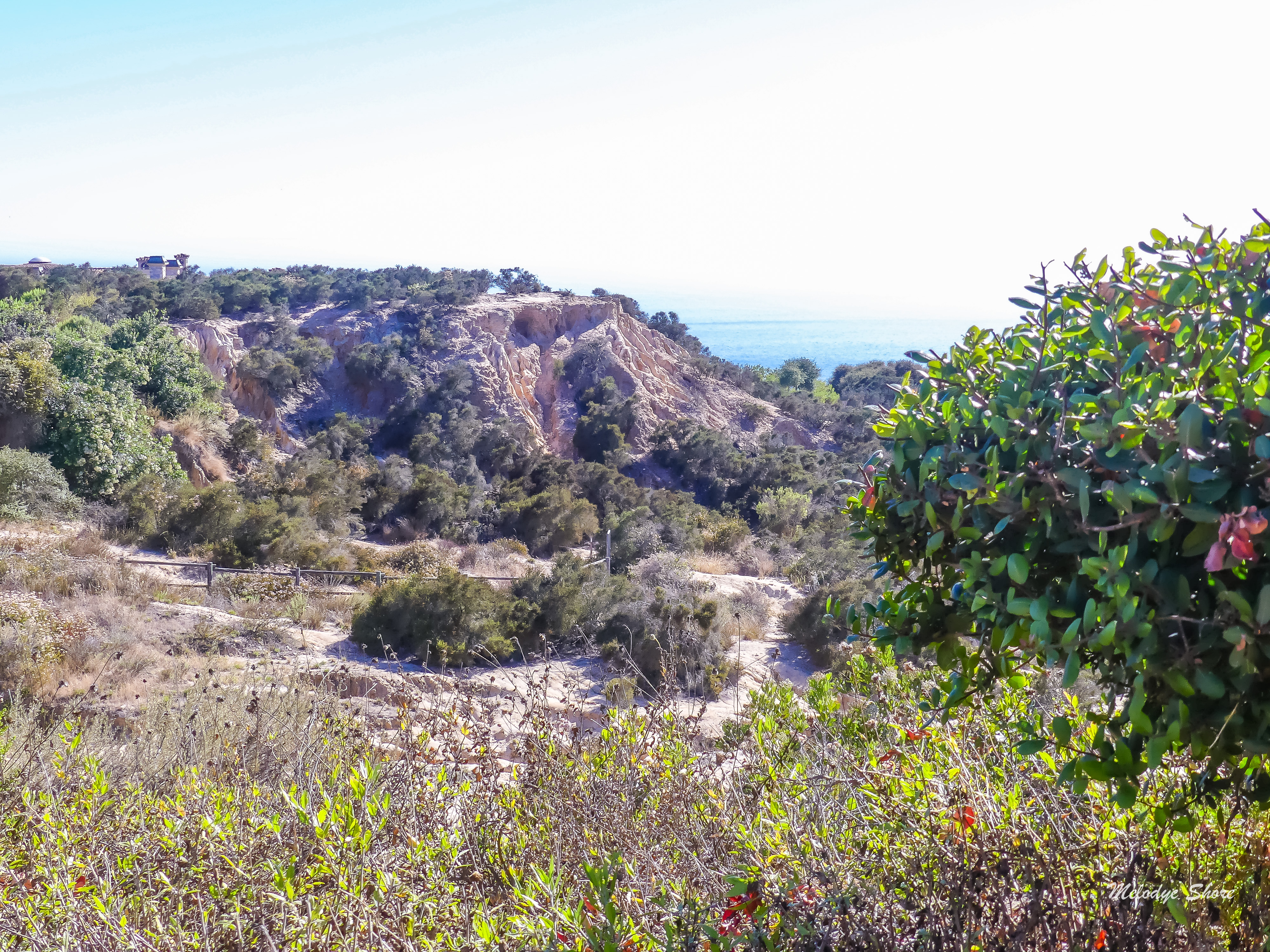I’m hiking these days with my friend Karin, who just so happens to be one of the most knowledgeable field guides around. I’d like someday to conquer even the most challenging trails in her book, 50 Hikes in Orange County. But given the lingering heat (not to mention a bum ankle), we began with a gentle walk along Dana Point Beach, and then ventured inland.

According to a docent, dolphins and whales are playing in this cove far longer than usual, thanks to warmer waters along the Pacific Coast.
Given our quiet (albeit insatiably curious) dispositions, we gladly trade Orange County’s glitzy ambiance for Mother Nature’s subtle grandeur.
There are rules, of course, posted at the trailheads for our protection and hers.

Cautions, too, but everything worth doing carries risks.

On the fire road that extends from Arch Beach Heights to Top of the World, Laguna Beach.
Dust swirls around our ankles. A hawk soars overhead, scouring the parched landscape for prey. We walk side-by-side mostly, discussing everything and nothing. Could [presidential candidate] say anything more outrageous? Oh, hey! How’s that writing project coming along?
Beep! Beep! A roadrunner streaks across the Stagecoach Trail, and then stops to pose for this paparazzo.

At its peak water levels, Karin tells me, this 12-acre, spring-fed lake is teeming with aquatic life, and surrounded by indigenous plants. Wildlife used to frequent this area, and it’s a popular spot for hikers and bikers.

Barbara’s Lake at capacity. Photo credit: Karin Klein (50 Hikes in Orange County).
Barbara’s Lake is officially recognized as the only natural, year-round lake in Orange County, but status doesn’t inoculate anything (or anyone) against the harsh effects of this drought.

The cracked silt of an emptied lake.
Songbirds chirp from the highest branches of graceful willows, just beyond the lake bed. Given the ease of our friendship (and the occasional, effortful climb), our conversation has long since drifted into silence. “Look!” we gesture, in wide-eyed wonderment. “Listen!” we say, without breathing a single word.

From this otherwise meager landscape, a patch of prickly pear cactus calls attention to itself. The fruit is edible, I know, and its root system helps prevent soil erosion. But human and beast, beware! Opuntia are known for hitchhiking on the flanks of passersby, and then propagating themselves, willy-nilly, across the desert floor.

When we stumble upon a pretty flower bouquet, Karin laments that she’s forgotten her hand scythe. Color me confused. “Every plant has a story,” Karin says, and when she explains, I’m wishing I’d thought to bring a pen and notepad.

Literary references to Artichoke Thistle precede Christ’s birth by several centuries. This cultivated form was ‘perfected’ in Medieval monastery gardens. However! Aesthetically pleasing as they might’ve been considered back then, California long ago yanked the welcome mat on these Mediterranean expats. Invasive as any marauding army, their seedlings grow quickly into sprawling, impenetrable flower patches with aggressive root systems that choke all native species in their path.
Tumbleweeds are immigrants, too, Karin tells me, imported from Russia on ships loaded with grain, and then ferried ashore by rats.

Untethered from their root systems, full-grown Tumbleweeds behave like giant sticker balls: bouncing across open fields and roadways; scattering seeds to the hot, dry winds; and attaching themselves like Velcro to any obstacles in their path. My father dodged them all the time on Route 66, back in the days when we traveled from one Pentecostal revival meeting to another.
More genteel than thistle and tumbleweeds, these drought-tolerant beauties are California natives. And I suspect you’d agree: Monkey Flowers are much prettier in their natural habitat than they appear on the laminated wildflower brochures, even when they’re a few days beyond their prime.

Some blossoms within the Monkey Flower genus are reminiscent of a monkey’s smiling face—or so the reference books say. I couldn’t see the resemblance, but maybe you will.
Native Americans gave these yellow gourds their common name: “Coyote Melon.” Karin wasn’t all that certain as to why that might be; but as I later learned, it’s not because coyotes eat them (they typically don’t), but because the plant itself is a “trickster.” As enticing as the melons might initially seem, the fleshy part is extremely bitter, and a single bite will give you horrible diarrhea for days! Even so, the oily seeds are edible and nutritious, and the emptied gourds make beautiful maracas. Most often, the gourds are left to wither and rot, and their seeds are carried away by winds and foraging critters.

If every plant tells a story (and the topography reveals its source), these first forays into the Orange County wilderness helped illustrate for me the inextricable link between ourselves and Mother Nature….the pulse of of our interdependent existence, writ large. For instance. Our garden was filled with the lingering fresh scent of rain yesterday morning—a late-night downpour, swallowed overnight by thirsty plants. Too little, I thought, to fill Barbara’s Lake, but certainly enough to nourish the wildlife on the neighboring hillside, and to help my drought-tolerant garden take root and grow. My field of vision, and my circle of concern, grows larger with every trail encounter.
Here’s hoping El Niño brings lots of rainstorms our way in the coming months. Meantime, I’ll double down on my ankle rehabilitation exercises, so that I can more easily navigate tide pools and rocky hillsides. Oh, the stories and pictures we’ll bring back from our hikes, come wildflower season next spring!



















